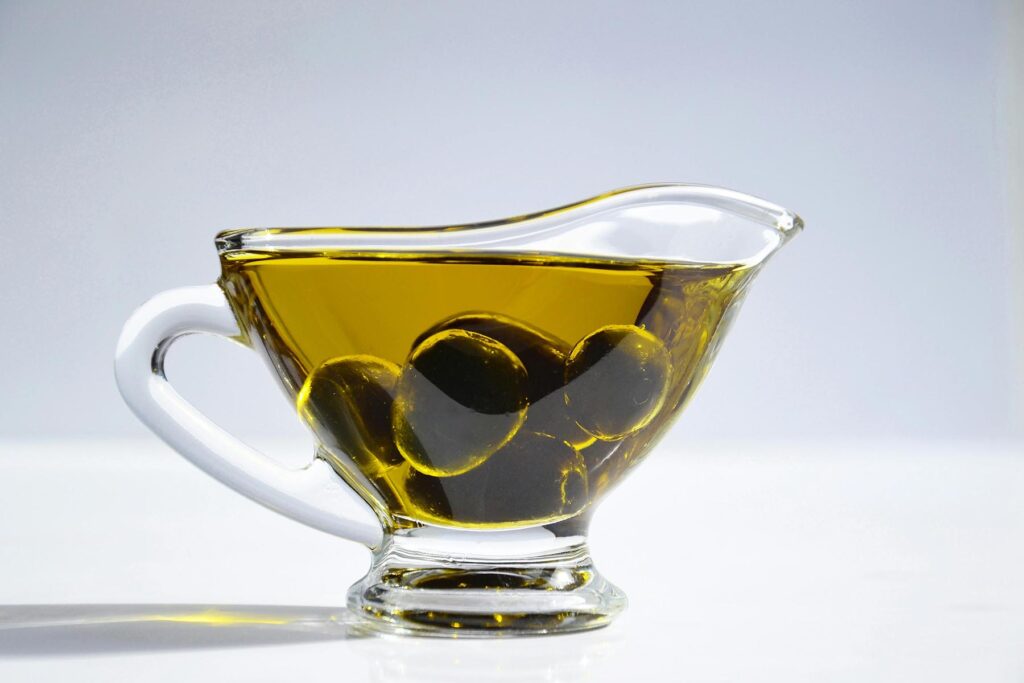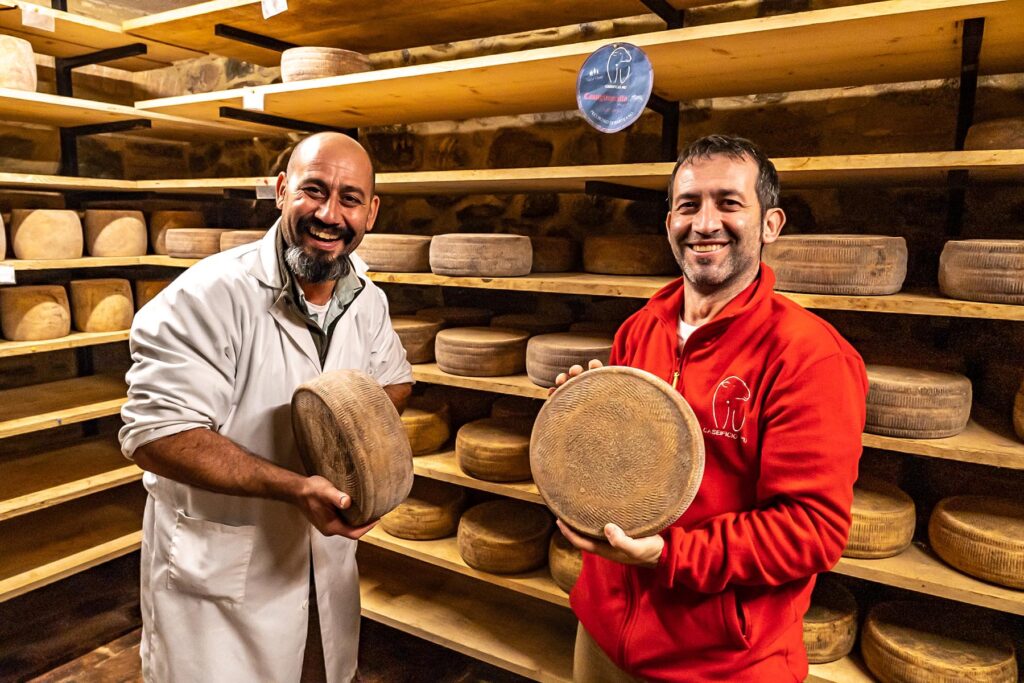
The flavor of olive oil can vary greatly depending on the country and region that it comes from. For example, Italian olive oil is often described as fruity and peppery, Spanish as herbaceous, and Greek with a strong peppery flavor. Why? The particular olive variety used, the climate and soil the trees grow in, and a few other factors all affect the taste of the final oil.
What varieties of olives are used to make olive oil?
There are over 500 different types of olives, each with its unique flavor. The most common varieties of olives used to make olive oil include (but are not limited to):
- Arbequina: Grown predominantly in Spain and known for its mild flavor.
- Frantoio: Grown predominantly in Italy and is known for its fruity flavor.
- Kalamata: Grown predominantly in Greece and known for its fruity flavor.
- Koroneiki: Grown predominantly in Greece and known for its peppery flavor.
- Picual: Grown predominantly in Spain and Italy and known for its intense olive flavor.
- And many, many more.
How do the climate and soil in which an olive tree is grown affect the oil’s flavor?
The climate and the soil in which the olive trees are grown can have a significant impact on the flavor of the oil. For example, olive trees grown in the warmer Mediterranean climate tend to have a more intense flavor than those produced in cooler temperatures. When it comes to soil, olives grown in sandy soil tend to have a more delicate flavor than those grown in clay soil.
Does the harvesting and processing method affect the flavor?
Yes! How the olives are harvested and processed can also affect the oil flavor. Olives harvested by hand (meaning picked by hand, one at a time, from the tree) tend to have a more intense flavor than those harvested by machine (shaken off of the tree and collected from nets spread across the ground or directly shaken into another machine). This is typically due to how ripe the olives are at the time of harvest.
Once the olives are harvested, they are taken to a processing plant, where they are washed, sorted, and then processed into oil. The olives are crushed to release their oil, separated from the solids, filtered, and bottled. The processing methods for olive oil can vary depending on the country, the individual producer, and the type of olive oil being produced. Some of the most common methods include:
- Mechanical pressing is the most common method for producing extra virgin olive oil. The olives are crushed to release the oil, and then the oil is separated from the solid parts of the olive.
- Centrifugation is used to produce virgin olive oil. The olives are crushed, and then the oil is separated from the solid parts of the olive using a centrifuge.
- Water extraction is used to produce pomace oil. The olives are crushed, and then the oil is separated from the solid parts of the olive using water.
Once the oil has been extracted, it is then graded. If the olive oil is found to be fruity with no defects and has an acidity less than or equal to 0.8, it is graded as extra virgin. The olive oil is graded as virgin if it contains minimal defects and acidity between 0.8 and 2.0.
Let’s look at a few specific regions: Argentina, Greece, Italy, Spain, and the United States.

Argentina:
In Argentina, the most popular olives used to make olive oil are the Arauco variety (also known as Arauco or Araucana olives) and the Manzanilla variety. These two varieties are widely cultivated in Argentina’s central olive-growing regions, such as La Rioja, San Juan, and Catamarca.
- The Arauco olives are small to medium in size and are known for their high oil content. They produce fruity and aromatic olive oil with a slightly bitter and peppery flavor profile. The Manzanilla olives, on the other hand, are larger and have a more rounded shape. They yield a milder and smoother olive oil with a fruity and slightly sweet taste.
Greece:
In Greece, the most popular olives used to make oil are Koroneiki. Koroneiki olives are highly regarded for their exceptional quality and are widely cultivated throughout the country, particularly in the regions of Peloponnese and Crete. While other olive varieties are grown in Greece, such as Athinolia, Mastoidis, and Manaki, the Koroneiki olive remains the most prominent and widely used variety for olive oil production in the country.
- Koroneiki olives are small in size but packed with flavor. They have a high oil content and are known for producing olive oil with an intense fruity aroma, a rich and robust taste, and a peppery finish. The unique characteristics of Koroneiki olives make them highly desirable for olive oil production. Greek extra virgin olive oils made from these olives are renowned worldwide for their exceptional quality.
Italy:
In Italy, the most popular olives used to make olive oil vary across different regions, as each region has its own preferred olive varieties. However, several notable olive varieties are widely recognized and commonly used for olive oil production throughout the country, including Frantoio, Leccino, Pendolino, Coratina, and Taggiasca.
- The Frantoio olive is one of Italy’s most prevalent and esteemed olive varieties. It is extensively cultivated in Tuscany and central Italy. The olives are medium-sized with a high oil content, producing a well-balanced oil with a fruity aroma, medium bitterness, and a peppery finish.
- Leccino olives are another popular variety grown in Tuscany, Umbria, and Liguria. They are medium to large in size and produce mild and delicate olive oil with a fruity flavor and a hint of sweetness.
- Pendolino olives are often used as a pollinator for other olive trees but are also suitable for oil production. They are small to medium-sized olives with a mild and delicate flavor profile, resulting in a smooth and slightly fruity oil.
- While primarily grown in southern Italy, especially in Puglia, Coratina olives are known for their high oil content and intense flavor. The resulting olive oil is characterized by its robust, fruity taste and a peppery and bitter finish.
- Taggiasca olives are predominantly grown in Liguria, particularly in Taggia. These small, round olives produce a delicate buttery olive oil with a mild flavor and hints of sweetness.
Spain:
Spain is one of the world’s largest producers of olive oil and boasts a wide range of olive varieties used for oil production. Spain’s most popular olive varieties used to make olive oil include Picual, Arbequina, Hojiblanca, Cornicabra, and Picudo.
- The Picual olive is Spain’s most widely planted olive variety, particularly in the region of Andalusia. It is highly regarded for its high oil content and excellent stability, making it ideal for olive oil production. Oils made from Picual olives are known for their intense fruity aroma, robust flavor, and slightly bitter and peppery finish.
- Arbequina olives are grown primarily in Catalonia but are also cultivated in other regions of Spain. These small olives produce delicate and smooth olive oil with a fruity flavor profile. Arbequina oils are often characterized by their mild and sweet taste, with notes of almonds and fresh herbs.
- Hojiblanca olives are commonly found in Andalusia, especially in the provinces of Córdoba, Málaga, and Seville. They are medium-sized olives that yield an oil with a fruity and herbal aroma, a slightly bitter taste, and a peppery finish. Hojiblanca oils are often appreciated for their balance and versatility.
- Cornicabra olives are predominantly grown in the central regions of Spain, such as Castilla-La Mancha and Toledo. These olives produce oils with a robust and fruity flavor profile, often accompanied by a slightly bitter and spicy taste. Cornicabra oils are highly regarded for their stability and longevity.
- Picudo olives are mainly cultivated in the region of Andalusia, particularly in the province of Córdoba. They produce olive oils with a distinctive fruity aroma, a sweet and slightly spicy taste, and a touch of bitterness. Picudo oils are recognized for their complexity and flavor nuances.
The United States of America:
In the United States, the most popular olives used for olive oil production vary across different regions due to variations in climate and growing conditions. Olive oil production in the United States is primarily concentrated in California, which is the largest olive oil-producing state; however, other states with favorable climates for olive trees, such as Arizona, Texas, Georgia, Oregon, and Florida, also produce excellent olive oils. It is important to note that the United States has a relatively young and growing olive oil industry compared to traditional olive oil-producing countries. A few notable olive varieties commonly used for olive oil production in the country include Arbequina, Koroneiki, Mission, Manzanillo, and Frantoio.
- Mission olives have a long history in the United States, predominantly grown in California, as Spanish missionaries brought them to the country in the 18th century. They produce milder and slightly buttery olive oil with a hint of sweetness.
- Manzanillo olives, also predominantly grown in California, are medium to large in size and produce olive oil with a fruity and mildly peppery flavor.
So, where on Earth does the best olive oil come from?
There is no single answer to this question since the best olive oils come from various countries, including the United States, Spain, Italy, Greece, Argentina, Croatia, and many more. Spain is currently the world’s largest producer of olive oil, followed by Italy and Greece. The best olive oil to buy is one you enjoy the taste of. As you can see, many different types of olive oil are available from various countries, so it is important to experiment until you find the ones you like.
What is your favorite olive oil? Where does it come from? Let us know in the comments below!


